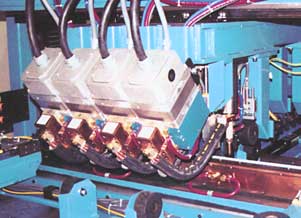Maximizing the Life of Resistance Welding Cables
Paying attention to secondary cables pays off
by Ed Langhenry Jr.
A number of components are needed to perform proper resistance welding. While transformers, controls, and the welding unit are certainly more glamorous, the easily overlooked resistance welding cables, also known as secondary cables, play a critical part in the resistance welding process.
Almost anyone would agree that the cost of a secondary cable is minimal compared with the cost of unplanned downtime. Everyone knows how expensive it is to shut down the production line without any forewarning. Secondary cables are usually the last item thought about, but with some planning, they can save welders time and money.
Minimum Standards
Resistance welding cables are classified as either air-cooled or water-cooled. No matter which type is used, they should be of high quality. Cables that use copper stranding and terminals that are classified as C11000 material provide the highest potential for conductivity. Typically, a 30-gauge stranding is recommended; in some cases, however, for flexibility or ease of installation, a 36-gauge stranding is more appropriate.
Similar consideration should be given to outer hose covers. Only nonconductive materials should be used, with a rating of 300 volts alternating current (AC). Lapped neoprene covers dipped with cotton braid wear well, s do nitrile covers for use with 36-gauge stranding. These basic, common components should be minimum standards for ethics.

Air Cooled Flexible Braided Jumper in use
Considerations by Cable Type
Air-Cooled. All cables deteriorate in a fraying or “shredded wheat” manner because of thermal and mechanical conditions. Minimizing these conditions will improve durability.
Unfortunately, air-cooled cables are in a constant state of oxidation. A silver-plated terminal (inside and outside) can help slow the oxidation process, which lowers resistance levels, resulting in less heat buildup and thus less stranding breakage. Using frayed or oxidized cables will result in poor, substandard welds.
The Resistance Welding Manufacturers’ Association (RWMA) Bulletin 16 includes selection charts with cable size recommendations.
Water-Cooled. Although water-cooled cables are affected by thermal and mechanical conditions, oxidation is not a factor because a water-cooled cable (both singe and dual conductors) is a soldered connection, while most air-cooled cables have a compressed connection. Also, the water-cooled cable is enclosed in a mandrel hose, which allows very little air exposure to the copper stranding.
Obviously, what is important to water-cooled cables is water. The importance of clean water with good water flow cannot be overemphasized. Normally, city water with low mineral content is satisfactory, and water flow becomes the decisive factor. In fact, water flow is more important tot cable life than any other factor.
If both flow and temperature can be controlled, cables life can be maximized. Two gallons per minute for single conductors and 2 ½ gallons per minute for dual conductors are minimum goals. Any more than the minimum will only help.
Kinking of the outer hose will result in a lack of water, which means reduced cable life. Cable manufacturers can provide the minimum bend radii specifications for their water-cooled and even air-cooled cables. Any unnecessary bends will hurt cable operation, so they should be installed with the largest possible bend radii.
General Recommendations
Aside from these specific air-cooled and water-cooled maintenance recommendations, additional measures can be taken to extend cable life.
Mounting surfaces (terminal ends) should be devoid of dirt and oil. Clean, dry surfaces makes for a good connection. Stainless steel bolts with Belleville washers are a good choice. The nuts should be made of a dissimilar material.
A range of 40 to 60 foot-pounds of torque is sufficient. Over time, because of expansion in the bolts caused by heat, the nuts will become loose. Tight, secure connections will make a difference and minimize arcing.
Cables must be properly sized to have maximum life. The four factors to consider are:
- Weld time.
- Number of welds per minute.
- Number of amps per weld.
- Length of cable.
Note that “on time” is the amount of time that current is flowing through the weld. “On time” is divided by the number of cycles (1/60 second) of “available time” (usually considered in a 1-minute time period) determines duty cycle.
Generally, shorter cable is better. Longer cables add resistance, so if the cable is not taxed mechanically with bend radii that are too short, a shorter cable is recommended.
Understanding these factors will determine the proper “Thousandths Circular Mill (MCM)” needed for cables. Cable suppliers are good sources for determining the correct size required for a resistance welding application.
Overlooked but Important
Resistance welding cables may not be fascinating, but they are essential to resistance welding performance. Transformers, controls and other items certainly are important for a resistance welding operation, but users must not overlook the importance of secondary cables. Giving secondary cables as much attention in planning as is given to other components will prolong the life of the cables.
Ed Langhenry Jr. is Sales and Marketing Representative with Representative with Watteredge-Uniflex, Inc., a leading manufacturer of resistance welding cables and a member company of the Resistance Welder Manufacturers’ Association (RWMA). The RWMA sets resistance welding standards.
Reprinted with permission from the March/April 1999 edition of Practical Welding Today.
T. J. Snow stocks a complete line of resistance welding cables as well as other spot welding supplies.
